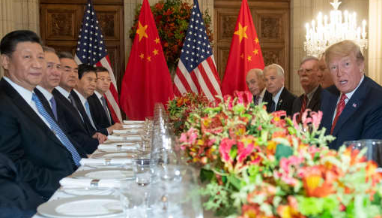China's central bank still has plenty of tools to counter detrimental effects of trade war, says governor
China's central bank still has plenty of tools that it can use to counter the detrimental effects of a trade war, its governor, Yi Gang, said on Sunday.
The Asian economic giant is in the center of a tariff fight with the U.S. The world's two largest economies have imposed tit-for-tat tariffs on each other's products, which have made investors nervous and is seen as a major risk in derailing the global economy.
"I think the downside risks from trade tensions are significant," Yi said at the International Banking Seminar, which was organized on the sidelines of the annual meetings of the International Monetary Fund and the World Bank in Bali, Indonesia.
"We still have plenty of monetary instruments in terms of interest rate policy, in terms of required reserve ratio. We have plenty of room for adjustment, in case we need it," he said, adding that China still wants a "constructive solution" to the ongoing trade frictions.
Yi's comments came just days after the IMF downgraded global growth forecasts for this year and next year to 3.7 percent, citing ongoing trade tensions that could hurt confidence. China's economy is expected to grow 6.6 percent this year — maintaining an earlier forecast — but slashed the country's 2019 growth estimate by 0.2 percentage points to 6.2 percent.
The IMF also said that at its worst, the tariff fight could knock 1.6 percentage points off China's economic growth over two years, although it added that it expects much of that impact to be offset by the Chinese government's policies to stimulate the economy.
Yi said he largely agrees with the IMF's assessment on how an escalating trade war could impact the global economy. But he said China is on track to meet its growth target of 6.5 percent this year and "maybe a little bit more."
'No ease, no tight'
The People's Bank of China has on four occasions this year cut the amount of reserves that banks must hold, unlocking more cash into the economy so that businesses and households could borrow more money to spend.
Many investors and economists — such as UBS and Nomura — have interpreted those moves as China's signal to ease monetary conditions. But Yi on Sunday maintained that China's monetary policy stance is still prudent and neutral.
A neutral monetary policy means the central bank is neither trying to slow nor stimulate the economy. When policy is said to be accommodative, it means the central bank is making it cheaper for businesses and households to borrow in hopes that they will increase spending and lift the economy.
The governor pointed to the growth of M2 money supply, which has grown at a slower pace this year to more align with China's economic expansion. M2 measures the amount of money in the economy that includes cash and other assets such as mutual funds and time deposits. In the last few months, that indicator has grown by around 8 percent year-over-year, down from previous year's double digits level and coming closer to growth in the overall economy, Yi said.
At the same time, the growth in China's total social financing — which measures credit in the economy such as loans and bonds — have maintained in a "reasonable range," he added.
"So if you look at the broad money, if you look at the interest rate and you look at monetary conditions, basically you can have the conclusion that we have a prudent and neutral stance monetary policy," Yi said
在线留言询价

China's Xi is about to deliver a speech that could have major consequences for the trade war

US will hold off on raising China tariffs to 25% as Trump and Xi agree to a 90-day trade truce

Expect a photo op and a 'mock deal' at the Trump-Xi meeting — not a long-term truce, says economist
- 一周热料
- 紧缺物料秒杀
| 型号 | 品牌 | 询价 |
|---|---|---|
| MC33074DR2G | onsemi | |
| RB751G-40T2R | ROHM Semiconductor | |
| BD71847AMWV-E2 | ROHM Semiconductor | |
| TL431ACLPR | Texas Instruments | |
| CDZVT2R20B | ROHM Semiconductor |
| 型号 | 品牌 | 抢购 |
|---|---|---|
| BU33JA2MNVX-CTL | ROHM Semiconductor | |
| ESR03EZPJ151 | ROHM Semiconductor | |
| STM32F429IGT6 | STMicroelectronics | |
| BP3621 | ROHM Semiconductor | |
| IPZ40N04S5L4R8ATMA1 | Infineon Technologies | |
| TPS63050YFFR | Texas Instruments |
AMEYA360公众号二维码
识别二维码,即可关注
























